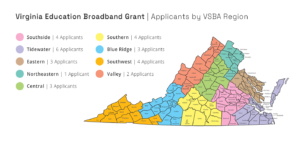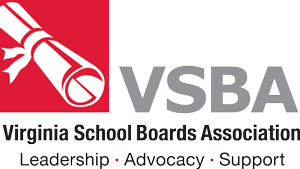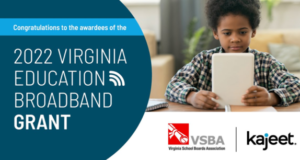Insights from the 2022 Virginia Education Broadband Grant
Examining Key Takeaways and Celebrating Awardees of the Grant.
The Digital Divide in Virginia
In Virginia, one in five students lack high-speed Internet at home. This digital divide, also known as the Homework Gap, puts students at a significant disadvantage to their more connected peers. It is incumbent upon education leaders to ensure that all students have a way to engage in online learning and access digital educational resources outside the classroom.
Kajeet Virginia Education Broadband Grant
In honor of the 115th anniversary of the Virginia School Boards Association, Kajeet partnered with VSBA to launch the Virginia Education Broadband Grant program. Out of the thirty applicants, nine school divisions, one per VSBA region, are being awarded up to $30,000 to support their digital equity initiatives. Awardees may use the grant for any combination of Kajeet Education Broadband solutions, including Wi-Fi hotspots, school bus Wi-Fi, LTE-embedded Chromebooks, and routers.

2022 Grant Awardees
Kajeet and VSBA are proud to announce the awardees of the 2022 Virginia Education Broadband Grant.
- Southside – Goochland County Public Schools
- Tidewater – Williamsburg/James City County Public Schools
- Eastern – Essex County Public Schools
- Northeastern – Fredericksburg City Public Schools
- Central – Nelson County Public Schools
- Southern – Lunenburg County Public Schools
- Blue Ridge – Botetourt County Public Schools
- Southwest – Tazewell County Public Schools
- Valley – Harrisonburg City Public Schools
Kajeet is also supporting all grant applicants who were not selected as awardees. Each will receive a consultation to discuss other funding options available to provide sustainable connectivity for their students.
Trends Observed & Key Takeaways
Within the 30 applications submitted, several overarching trends emerged that together serve to illustrate the current landscape of the Commonwealth’s digital divide.
Disproportionate Effect on Rural Communities
An overwhelming number of applicants cited the lack of affordable broadband options, poor coverage, and income disparities in rural areas as the main challenges faced when connecting students.
“Because this is a rural area it is not seen as financially feasible to run cabling in many situations. The local cable provider then pushes these costs to the customers to pay if they wish to get connected.”
- Director of Technology, 2022 Grant Applicant
Funding Challenges
Federal funding, including the Elementary and Secondary School Emergency Relief Fund (ESSER) and the Emergency Connectivity Fund (ECF), provided divisions the opportunity to address the Homework Gap in their communities during the pandemic.
However, based on the need established by applicants, funding is still a challenge when it comes to connecting students. Furthermore, many federal funding sources are not permanent – creating a funding cliff down the road.
The Need for Mobile Connectivity
Applicants have conveyed the need for more mobile connectivity options for students, rather than solely focusing on fixed broadband solutions.
Many students stay with different family members after school, work an after-school job, or participate in extracurricular activities. It is also important to consider student populations who would benefit from mobile connectivity, including hospital-bound students, students in foster care, and students experiencing homelessness.
School Bus WiFi
Almost one third of applicants incorporated school bus WiFi into their student connectivity plan. On average, students spend 46 minutes roundtrip on the bus traveling to and from school each day. This time can be spent completing online assignments, studying for an exam, or accessing additional educational resources.
Questions School Board Members Can Ask
As a school board member, your voice makes a difference in the lives of under-connected students and families as you advocate for their equal access to the wealth of opportunities and resources available online.
Here are a few questions to help guide your school board’s digital equity strategy.
- How many students lack home Internet access in your school division?
- How, and when, does the school identify students or staff who need digital access?
- Does your school board have a policy to support digital inclusion for every student?
- Does the school board policy ensure home access for students and staff?
- What funding options are available to support digital inclusion in your school division?
The Future of Student Connectivity
As our world becomes increasingly digital – in which access to resources like STEM tools and software, digital certifications, secondary education applications, and job opportunities are all hosted online – this inequity has long-term impacts on these students’ ability to succeed.
The shared goal of eliminating the Homework Gap can seem a daunting task. But by working together with K-12 leaders, we believe we can reach a future in which every student is connected to reliable broadband access.

